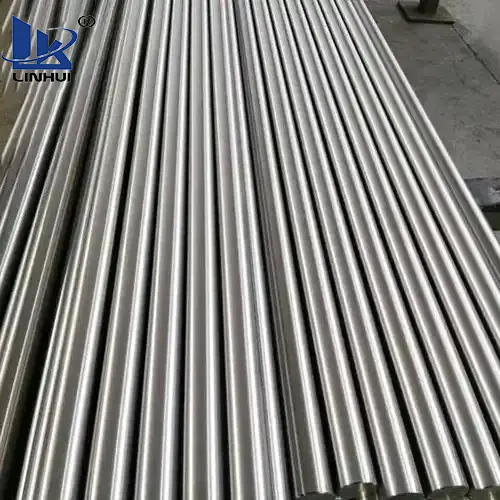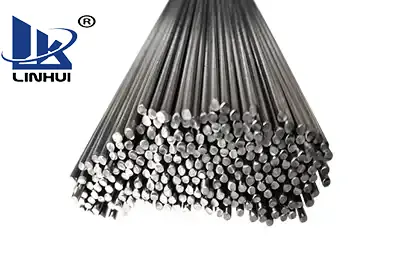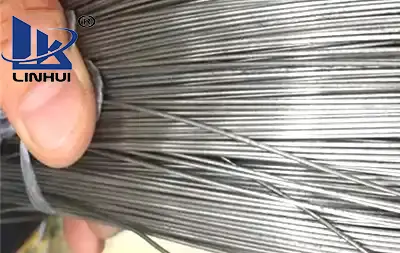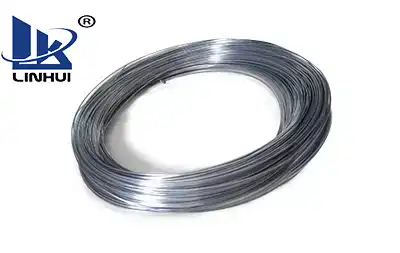Ti6Al7Nb Titanium Alloy Bar
Forgings:
Ring size capability
OD ≤ 1300mm, Height ≤ 250mm
Disc size capability
OD ≤ 1100mm, Height ≤ 40mm
Description of Ti6Al7Nb Titanium Alloy Bar
Ti-6Al-7Nb (UNS designation R56700) is an alpha-beta titanium alloy first synthesized in 1977 containing 6% aluminum and 7% niobium. It features high strength and has similar properties as the cytotoxic vanadium-containing alloy Ti-6Al-4V. Ti-6Al-7Nb is used as a material for hip prostheses.
Ti-6Al-7Nb is one of the titanium alloys that is built of hexagonal α phase (stabilized with aluminum) and regular body-centered phase β (stabilized with niobium). The alloy is characterized by added advantageous mechanical properties, it has higher corrosion resistance and is biotolerant in relation to Ti-6Al-4V alloys.
| Chemical Composition Limits | |||||||||
| Weight % | Al | Nb | Ta | Fe | O | C | N | H | Ti |
| Ti6Al7Nb | 5.5-6.6 | 6.5-7.5 | 0.50 max | 0.25 max | 0.20 max | 0.08 max | 0.05 max | 0.009 max | Bal |
Typical Mechanical Properties
| Material | Tensile Strength | Yield Strength | Elongation in 5D (%) | Reduction of Area | ||
| ksi | Mpa | ksi | Mpa | |||
| Ti6Al7Nb | 145 | 1000 | 131 | 900 | 12 | 35 |
Forms
Bar, Rod, Wire:
Dia. 1 – 300mm, Length: 500 – 6000mm
Forgings:
Ring size capability
OD ≤ 1300mm, Height ≤ 250mm
Disc size capability
OD ≤ 1100mm, Height ≤ 40mm
Production
Ti6Al7Nb titanium alloy bar is produced by powder metallurgy methods. The most common methods are hot pressing, metal injection moldering, and blending and pressing. In the production of Ti-6Al-7Nb, usually, a sintering temperature between 900-1400 o C is used. Altering the sintering temperature gives the Ti-6Al-7Nb different properties such as different porosity and microstructure. It also gives a different composition between alpha, beta, and alpha+beta phases. In recent years Ti-6Al-7Nb alloys could also be made by different 3D-printer techniques such as SLM and EBM.
Heat treatment
Heat treatment of titanium is demonstrated to have significant influences on reducing the residual stresses and improving the mechanical properties (i.e. tensile strength or fatigue strength by solution treatment and aging). Moreover, heat treatment provides an ideal combination of ductility, machinability, and structural stability due to the differences in microstructure and cooling rates between α and β phases.
The cooling rate has an impact on the morphology. When the cooling rate is reduced for example from air cooling to slow cooling, the morphology of the transformed α increases in thickness and length and is contained within fewer, larger α colonies. The α colony size is the most important microstructural property due to its influences on the fatigue properties and deformation mechanics of β processed α+ β alloys.
Applications
1. Implant Devices in Healthcare:
1)Failed Hard Tissue: Implant devices play a critical role in replacing or repairing hard tissues like bones. When individuals experience fractures, degenerative bone diseases, or other issues, artificial bone plates and screws are used to stabilize and aid in the healing process.
2)Artificial Hip and Knee Joints: Many people suffering from joint problems, such as arthritis, benefit from the installation of artificial hip or knee joints. These implants can help restore mobility and reduce pain.
3)Cardiac Valve Prostheses: Heart valve issues can be life-threatening. Cardiac valve prostheses are used to replace malfunctioning heart valves, allowing patients to regain normal heart function.
4)Pacemakers and Artificial Hearts: In the case of cardiac rhythm disturbances or severe heart failure, pacemakers and artificial hearts can be implanted to regulate and support heart function.
2. Dental Applications:
In dentistry, inserts are regularly used to supplant missing teeth. Dental inserts are counterfeit tooth roots that are carefully positioned into the jawbone to help substitution teeth, like crowns, scaffolds, or false teeth. This innovation has changed the field by furnishing patients with a more long-lasting and regular-looking answer for tooth misfortune.
3. Aircraft Materials:
The notice of "Airplane Materials" in the first text might recommend the utilization of cutting-edge materials, conceivably roused by embedded innovation, in the aeronautic trade. These materials could be utilized in the development of airplane parts and frameworks to upgrade execution, decrease weight, or further develop sturdiness. Such materials could exploit areas of strength for the lightweight properties tracked down in specific embed materials, like titanium or high-level composites.
Biocompatibility
Ti6Al7Nb titanium alloy bar has high biocompatibility. The oxides from Ti-6Al-7Nb are saturated in the body and are not transported in vivo or are a bioburden. The alloy will not create adverse tissue tolerance reactions and creates fewer giant cell nuclei. Ti-6Al-7Nb also shows high compatibility with ingrowth in the human body.
Specification
Designations for Ti-6Al-7Nb in other naming conventions include:
UNS: R56700
ASTM Standard: F1295
ISO Standard: ISO 5832-11
| Packing & Shipping |
1. Accept the request/customized packing | |
2. Normally, goods will packed in poly bags, drawstring bags, carrying bags, and cartons | |
3. For the sample, we will use TNT, Fedex, UPS, DHL, etc to ship it, | |
4. For bulk, it depends on the qty, by air, by train or by sea are all available. |



















